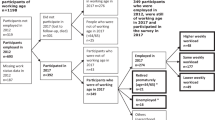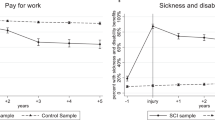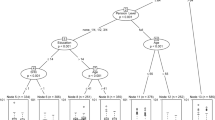Abstract
Study design
Longitudinal, population-based survey.
Objective
To examine determinants of between-person differences in labor market participation of individuals with spinal cord injury (SCI) living in Switzerland and their potential importance for policy.
Setting
Community.
Methods
Longitudinal information on labor market participation (i.e., paid work or not) was obtained from 1198 and 1035 individuals of working-age participating in the 2012 and 2017 SwiSCI community survey, respectively. Determinants of between-person variation in labor market participation were examined using mixed effects logistic regression, controlling for within-person variation. Employment rates were predicted using counterfactual data for modifiable determinants.
Results
The employment rate was 56% for the 2012 and 61% for the 2017 survey. Labor market participation was affected mostly by static (sex, nationality, SCI severity), temporal (age), dynamic (education level, functional independence, chronic pain), and policy-related (general pension, disability pension level) determinants. Counterfactual (what-if) predictions indicated the highest improvement of employment rates for strategies that increase functional independence (up to 6% increase), foster education (5%), reduce chronic pain (2%), or promote a shift to partial disability pensions (15%).
Conclusions
Between-person variation in labor market participation of persons with SCI is influenced by various temporal, static, dynamic, and policy-related determinants. Our results suggest that policy strategies aimed at enhancing the employment rate of the Swiss SCI population may particularly invest in programs promoting functional independence, education, and partial pension levels that are more adequate for ensuring sustainable employment.
Similar content being viewed by others
Log in or create a free account to read this content
Gain free access to this article, as well as selected content from this journal and more on nature.com
or
Data availability
Owing to our commitment to SwiSCI study participants and their privacy, data sets generated during the current study are not made publicly available but can be provided by the SwiSCI Study Center based on reasonable request (contact@swisci.ch).
References
Ottomanelli L, Lind L. Review of critical factors related to employment after spinal cord injury: implications for research and vocational services. J Spinal Cord Med. 2009;32:503–31.
Lidal IB, Huynh TK, Biering-Sörensen F. Return to work following spinal cord injury: a review. Disabil Rehabil. 2007;29:1341–75.
Cao Y, Krause JS. Estimation of indirect costs based on employment and earnings changes after spinal cord injury: an observational study. Spinal Cord. 2020;98:909–13.
Leiulfsrud AS, Ruoranen K, Ostermann A, Reinhard JD. The meaning of employment from the perspective of persons with spinal cord injuries in six European countries. Work. 2016;55:133–44.
Frieden L, Winnegar AJ. Opportunities for research to improve employment for people with spinal cord injuries. Spinal Cord. 2012;50:379–81.
Reinhardt JD, Post MW, Fekete C, Trezzini B, Brinkhof MW. Labor market integration of people with disabilities: results from the swiss spinal cord injury cohort study. PloS ONE. 2016;11:e0166955.
Trenaman L, Miller WC, Queree M, Escorpizo R. SCIRE research team. modifiable and non-modifiable factors associated with employment outcomes following spinal cord injury: a systematic review. J Spinal Cord Med. 2015;38:422–31.
Escorpizo R, Miller WC, Trenaman LM. Work and employment. In: Eng JJ, Teasell RW, Miller WC, Wolfe DL, Townson AF, Hsieh JTC, et al. editors. Spinal cord injury rehabilitation evidence. Vancouver; 2012;4:1–22.
Leiulfsrud AS, Solheim EF, Reinhardt JD, Post MWM, Horsewell J, Biering-Sörensen F, et al. Gender, class, employment status and social mobility following spinal cord injury in Denmark, the Netherland, Norway and Switzerland. Spinal Cord. 2020;58:224–31.
Marti A, Boes S, Lay V, Escorpizo R, Trezzini B. The association between chronological age, age at injury and employment: Is there a mediating effect of secondary health conditions? Spinal Cord. 2016;54:239–44.
Burns SM, Boyd BL, Hill J, Hough S. Psychosocial predictors of employment status among men living with spinal cord injury. Rehabil Psychol. 2010;55:81–90.
Murphy G, Middleton J, Quirk R, De Wolf A, Cameron ID. Prediction of employment status one year post-discharge from rehabilitation following traumatic spinal cord injury: an exploratory analysis of participation and environmental variables. J Rehabil Med. 2009;41:1074–9.
Krause JS, Reed KS. Barriers and facilitators to employment after spinal cord injury: underlying dimensions and their relationship to labor force participation. Spinal Cord. 2011;49:285–91.
Schwegler U, Fellinghauer CS, Trezzini B, Siegrist J. For the SwiSCI Study Group. Factors associated with labor market participation of persons with traumatic SCI in Switzerland: analyzing the predictive power of social background, health, functional independence, and the environment. Spinal Cord. 2019;58:411–22.
Marti A, Escorpizo R, Schwegler U, Staubli S, Trezzini B. Employment pathways of individuals with spinal cord injury living in Switzerland: a qualitative study. Work. 2017;58:99–110.
Krause JS, Terza JV. Injury and demographic factors predictive of disparities in earnings after spinal cord injury. Arch Phys Med Rehabil. 2006;87:1318–26.
Post MW, Brinkhof MW, von Elm E, Boldt C, Brach M, Fekete C, et al. Design of the Swiss Spinal Cord Injury Cohort Study. Am J Phys Med Rehabil. 2011;90:S5–16.
Brinkhof MW, Fekete C, Chamberlain JD, Post MW, Gemperli A. Swiss national community survey on functioning after spinal cord injury: Protocol, characteristics of participants and determinants of non-response. J Rehabil Med. 2016;48:120–30.
Gross-Hemmi MH, Gemperli A, Fekete C, Brach M, Schwegler U, Stucki G. Methodology and study population of the second Swiss national community survey of functioning after spinal cord injury. Submitted to Spinal Cord. 2020. https://doi.org/10.1038/s41393-020-00584-3. Epub ahead of print.
Swiss Spinal Cord Injury Cohort Study (SwiSCI). Community survey. Nottwil: Schweizer Paraplegiker-Forschung; 2018. https://www.swisci.ch/en/research-projects-home/study-design/community-survey/survey-2017. Accessed 15 Nov 2020.
UNESCO. International Standard Classification of Education (SCED). Paris: UNESCO; 1997.
Fekete C, Eriks-Hoogland I, Baumberger M, Catz A, Itzkovich M, Luthi H, et al. Development and validation of a self-report version of the Spinal Cord Independence Measure (SCIM III). Spinal Cord. 2013;51:40–7.
Prodinger B, Ballert CS, Brinkhof MW, Tennant A, Post MW. Metric properties of the spinal cord independence measure—self report in a community survey. J Rehabil Med. 2016;48:149–64.
Kalpakjian CZ, Scelza WM, Forchheimer MB, Toussaint LL. Preliminary reliability and validity of a Spinal Cord Injury Secondary Conditions Scale. J Spinal Cord Med. 2007;30:131–9.
Sangha O, Stucki G, Liang MH, Fossel AH, Katz JN. The self-administered comorbidity questionnaire: a new method to assess comorbidity for clinical and health services research. Arthritis Rheum. 2003;49:156–63.
Twisk J. Missing data in longitudinal studies. In: Applied longitudinal data analysis for epidemiology: a practical guide. Cambridge: Cambridge University Press; 2013. p. 212–36.
Murphy GC, Jackson MS. Barriers to sustained return-to-work reported by those returning to work post traumatic spinal cord injury rehabilitation. Open Rehabil J. 2013;6:21–5.
Weissberg M. Berentung von jungen Querschnittgelähmten. Paracontact. 2008;1:15.
Müller R, Landmann G, Béchir M, Hinrichs T, Arnet U, Jordan X, et al. Chronic pain, depression and quality of life in individuals with spinal cord injury: Mediating role of participation. J Rehabil Med. 2017;49:489–96.
Trezzini B, Schwegler U, Reinhardt JD. Work and wellbeing-related consequences of different return-to-work pathways of persons with spinal cord injury living in Switzerland. Spinal Cord. 2018;56:1166–75.
Acknowledgements
We thank the SwiSCI Steering Committee with its members Xavier Jordan, Fabienne Reynard (Clinique Romande de Réadaptation, Sion); Michael Baumberger, Hans Peter Gmünder (Swiss Paraplegic Center, Nottwil); Armin Curt, Martin Schubert (University Clinic Balgrist, Zürich); Margret Hund-Georgiadis, Kerstin Hug (REHAB Basel, Basel); Laurent Prince (Swiss Paraplegic Association, Nottwil); Heidi Hanselmann (Swiss Paraplegic Foundation, Nottwil); Daniel Joggi (Representative of persons with SCI); Nadja Münzel (Parahelp, Nottwil); Mirjam Brach, Gerold Stucki (Swiss Paraplegic Research, Nottwil); Armin Gemperli (SwiSCI Coordination Group at Swiss Paraplegic Research, Nottwil).
Funding
SwiSCI is hosted and funded by Swiss Paraplegic Research.
Author information
Authors and Affiliations
Contributions
US, MWGB, and CF were responsible for designing the conceptual framework of the study. MWGB conducted the statistical analysis. US and MWGB prepared the paper. CF, MF, KK, and SS substantially contributed to the data interpretation or the article preparation. SS provided valuable input from vocational rehabilitation practice.
Corresponding author
Ethics declarations
Conflict of interest
The authors declare that they have no conflict of interest.
Ethical approval
Ethical approval for the SwiSCI Survey 2012 was granted by the principal ethics committee on research involving humans of the Canton of Lucerne (KEK Luzern, internal application 11042, approved 28.06.2011) and subsequently endorsed by the additional involved cantonal ethics committees of the Cantons Basel-Stadt (EK Basel, internal application 306/11, approved 06.09.2011) and Valais (CCVEM Sion, internal application CCVEM042/11, approved 06.12.2011). Ethical approval for the SwiSCI Survey 2017 was granted by the leading ethical institution Ethikkommision Nordwest-und Zentralschweiz (EKNZ, Project-ID: 11042 PB_2016-02608, approved Dec 2016). We certify that all applicable institutional and governmental regulations concerning the ethical use of human volunteers were followed during the course of this research.
Additional information
Publisher’s note Springer Nature remains neutral with regard to jurisdictional claims in published maps and institutional affiliations.
Supplementary information
Rights and permissions
About this article
Cite this article
Schwegler, U., Fekete, C., Finger, M. et al. Labor market participation of individuals with spinal cord injury living in Switzerland: determinants of between-person differences and counterfactual evaluation of their instrumental value for policy. Spinal Cord 59, 429–440 (2021). https://doi.org/10.1038/s41393-020-00598-x
Received:
Revised:
Accepted:
Published:
Issue date:
DOI: https://doi.org/10.1038/s41393-020-00598-x
This article is cited by
-
Predicting change in labour market participation of people with spinal cord injury (SCI): longitudinal evidence from the Swiss SCI community survey
Spinal Cord (2022)
-
Pathways to loneliness: a mediation analysis investigating the social gradient of loneliness in persons with disabilities in Switzerland
International Journal for Equity in Health (2021)



